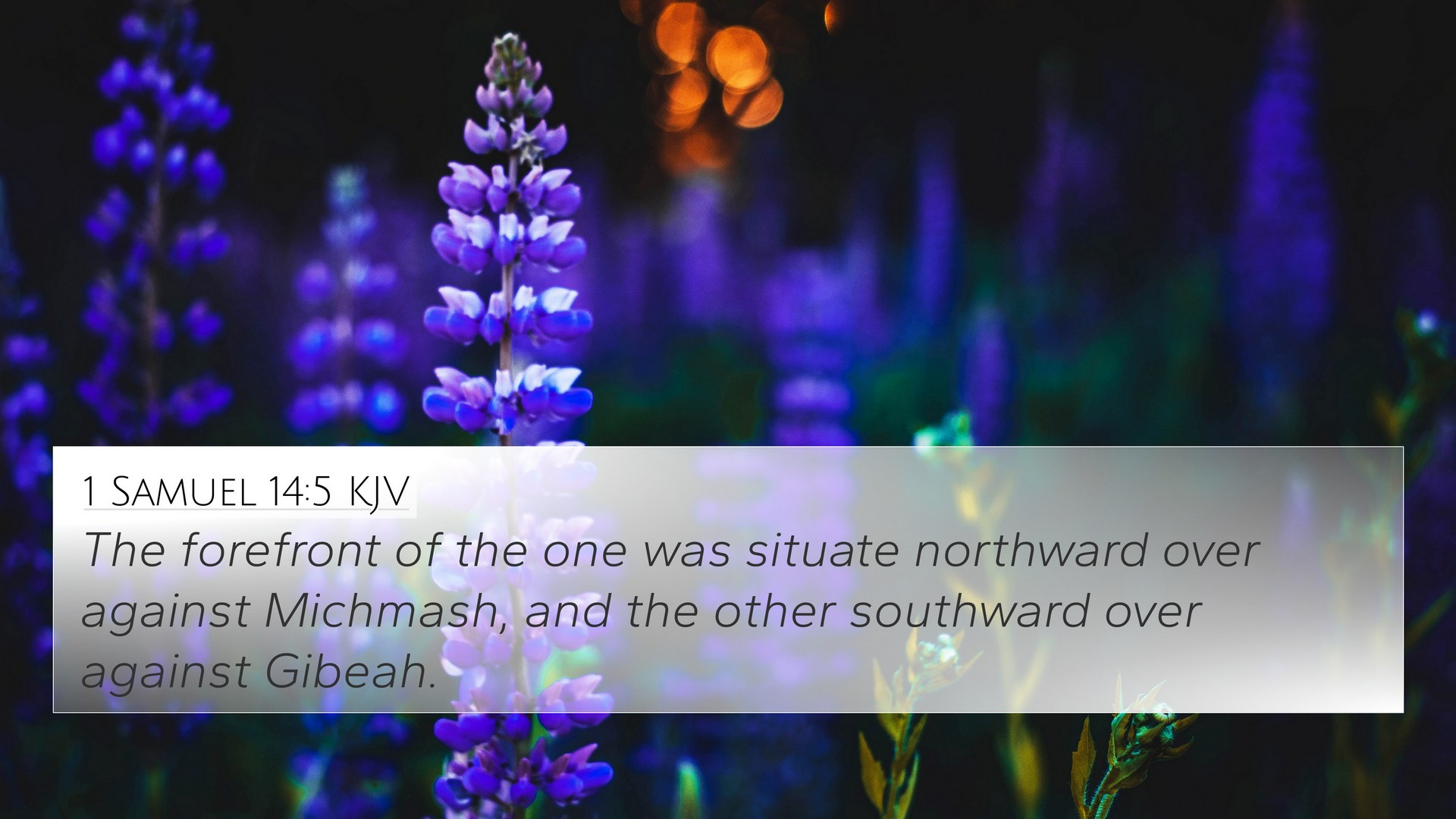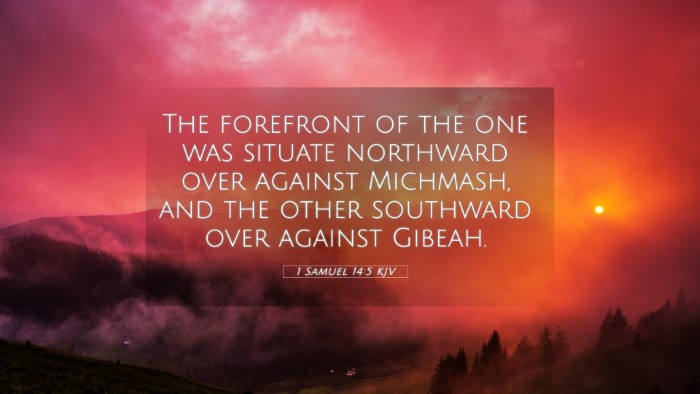Understanding 1 Samuel 14:5
The verse 1 Samuel 14:5 states, "The front of one was situate northward over against Michmash, and the other southward over against Gibeah." This verse describes a geographical detail that plays a significant role in the context of warfare strategies employed by Saul and Jonathan against the Philistines.
Summary of Context
In this chapter, we find Jonathan, the son of King Saul, taking initiative against the Philistine army. The verse emphasizes the positioning of forces, highlighting the tactical moves made during battle. Both geographic references signify the strategy of separation and positioning in warfare, which is pertinent to understanding the unfolding events.
Insights from Commentaries
Matthew Henry's Commentary
Matthew Henry notes the significance of geographic locations in battle strategies. He emphasizes that Jonathan’s actions demonstrate faith and boldness in pursuing God's guidance against enemy forces. The reference to Michmash and Gibeah illustrates the strategic advantage necessary for success, metaphorically reinforcing the concept that wise positioning can lead to victory.
Albert Barnes' Notes
Albert Barnes points out that the mention of the two locations stresses the need for discernment in leadership. The dual positioning serves not just military purposes, but also symbolizes the separation between the believers and the opposing forces. Barnes reinforces that God often operates in ways that may seem strategically weak but ultimately lead to triumph, suggesting that true strength lies in reliance upon Him.
Adam Clarke's Commentary
Adam Clarke elaborates on the landscape of the battle described. His commentary reflects on the manner in which God’s providence directed events, suggesting that the locations not only played a physical role but also a spiritual one in the unfolding narrative of Israel's fight against oppression. Clarke focuses on the themes of faith and divine intervention in strategic matters as pivotal in this historic context.
Thematic Connections and Biblical Cross-References
Understanding the connections between Bible verses can offer significant insights. Here are key cross-references that relate to 1 Samuel 14:5:
- 1 Samuel 13:6: Details the desperation of Israel during the Philistine threat, illustrating the lead-up to Jonathan's bold decision.
- 1 Samuel 14:1: Jonathan’s initiative decisions are framed as acts of faith, encouraging further engagement with the enemy.
- Proverbs 21:31: "The horse is made ready for the day of battle, but victory belongs to the Lord," which emphasizes reliance on divine intervention.
- Hebrews 11:32-34: Celebrates the faith of those who through God’s strength subdued kingdoms, affirming Jonathan’s faith-based actions.
- 1 Samuel 14:6: Jonathan expresses his faith in God's ability to save regardless of the odds, reinforcing the theme of divine providence in battle.
- Joshua 10:12-14: God intervenes in battles, paralleling the divine assistance sought by Jonathan.
- 2 Corinthians 10:4: "For the weapons of our warfare are not carnal, but mighty through God," echoing the spiritual nature underlying the physical battles fought.
- Matthew 10:16: Jesus advises his disciples to be wise as serpents and innocent as doves, akin to the strategic wisdom observed in Jonathan’s actions.
- James 1:5: Encourages believers to seek wisdom from God in all matters, relevant here as Jonathan seeks divine guidance for their military undertakings.
- Romans 8:31: "If God is for us, who can be against us?" illustrating the assurance seen in Jonathan's stance against the Philistines.
Methods for Cross-Referencing Biblical Texts
Cross-referencing Bible verses can deepen understanding and enhance Bible study. Here are some tools and methods for effective cross-referencing:
- Bible Concordance: A dictionary-like index that allows users to find words or themes across scripture.
- Bible Cross-Reference Guide: Specific guides available that relate various scriptures by themes, concepts, or narratives.
- Cross-Reference Bible Study: Methods focusing on thematic studies that connect different sections of the Bible through related verses.
- Bible Reference Resources: Digital tools and apps that help find and analyze cross-references quickly.
- Chain References: Connecting verses in a sequence to explore a particular doctrine or narrative.
- Identifying Themes: Group verses together by thematic content to uncover broader spiritual concepts.
- Diving into Biblical Context: Understanding the historical and cultural context helps uncover deeper meanings in cross-references.
Conclusion
1 Samuel 14:5 serves as a reminder of the interplay between faith, strategy, and divine providence in warfare, both spiritually and physically. By examining the connections between related scriptures and employing effective cross-referencing methods, readers can enhance their understanding of the Biblical narrative and its rich thematic content.
Engaging with Scripture and fostering an understanding of inter-Biblical dialogues can transform one’s approach to Bible study, offering new insights and deeper connections between verses.


